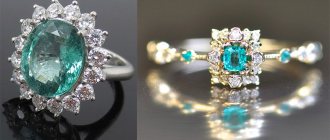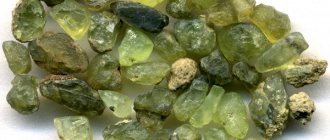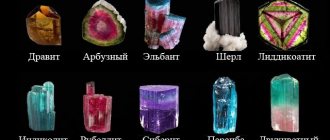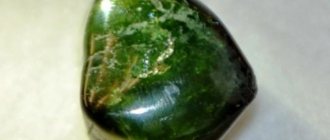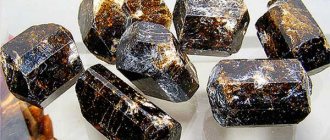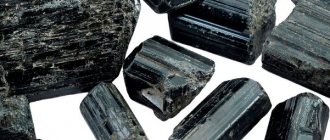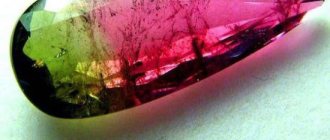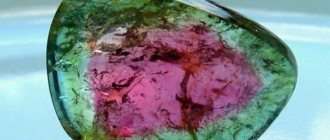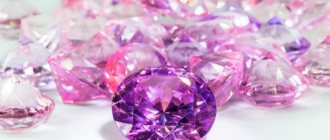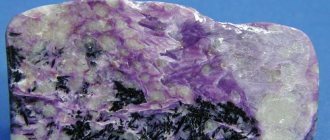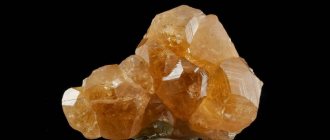In the summer of 1987, the world jewelry industry was shocked by sensational news that arrived from Brazil - a previously unknown type of tourmaline had been discovered in the state of Paraiba. Each of its blue-turquoise crystals seemed to contain a small neon light bulb. This marvelous reflection appeared in the stone at the slightest light.
Please read the article “Tourmaline – a gem with many faces”
The Luck of Miner Heitor Barbosa
In addition to many Indian and mixed nationalities, in Brazil there is a special motley “tribe”, which includes desperate treasure seekers of all nations living in a huge tropical country. These are garimpeiros , professional miners, most of them poor adventurers who never miss their chance to get rich. They often conduct excavations illegally, and therefore cannot openly sell their finds for good money.
A Brazilian police river patrol caught up with a miner illegally panning for gold.
But one of these miners, named Heitor Barbosa, approached the matter systematically. He acquired a license to search for gems in the floodplain of the Paraiba River, which crosses the state of the same name. The mines of precious stones that once existed here have long been exhausted and abandoned. On the surface of the dug-up earth, only trenches and heaps of sifted rock remained. But Signor Heitor decided to once again “comb” this God-forgotten territory.
His professional miner's instinct did not let him down. Five years later, having turned over mountains of rocky soil, Heitor Barbosa found what he was looking for.
Blue tourmaline crystals
The find exceeded our wildest expectations. A stubborn, lucky garimpeiros discovered a deposit of unprecedented blue tourmaline with a deep inner glow.
For several years, a new type of tourmaline was called by the name of the successful discoverer - heytorite , but this name did not become official and is no longer used.
Who is it suitable for?
Of all the signs of the Zodiac, the stone finds harmony most with Pisces, Cancer and Scorpio. It will be a powerful amulet for Libra and Aquarius. But Virgos and Capricorns are not recommended to wear the gem due to different energy levels. For other signs, the mineral will become neutral - it will bring neither benefit nor harm.
In any case, when buying a Paraiba, follow your gut feelings. If you feel positive energy from it, then you can safely purchase it.
Separated by an ocean
Gemologists see similarities in the structure and composition of Paraiba tourmalines with the Mediterranean gem elbaite (polychrome tourmaline), mined on the island of Elba (Italy).
Paraiba tourmaline owes its unusual hue to the presence in the crystal of a unique combination of copper, magnesium and manganese ions, as well as some structural features. This unique set of stone properties has not been found in other deposits.
But within a few years, geologists overcame the Brazilian monopoly. Blue tourmaline was discovered overseas, on the island of Madagascar. This discovery was followed by others - tourmaline, almost indistinguishable from Paraiba stone, was produced by new mines in Mozambique and Nigeria.
Geological puzzle
Geologists believe that the coincidence of the structure, composition and color of African and Brazilian Paraiba tourmalines is not an accident. These stones were formed under the same conditions; their deposits were once located nearby, on the proto-continent Pangea, which 150 million years ago split into smaller continents known to us today. So some of the deposits remained in South America, and some “sailed” overseas along with Africa and Madagascar due to continental drift.
World map
Take a look at the world map. The outlines of the western coast of Africa, like an element of a puzzle, fit the outlines of the opposite coast of the Atlantic - the eastern coast of South America. And the Brazilian state of Paraiba sits on a ledge that would complete this geological puzzle, perfectly filling the Gulf of Guinea. This is where Guinea is located.
And the island of Madagascar follows the coastline of continental Mozambique. It turns out that they were once one.
Visual animation of continental drift:
The movement of lithospheric plates that carry the Earth's continents is confirmed not only by geology, but also by paleontology. On now widely separated puzzle coasts, scientists have discovered the remains of the same dinosaur species. Land lizards couldn't swim across the ocean, could they?
Presentation in Tucson
In 1990, Brazilian blue tourmaline was loudly presented at the largest annual professional gem fair, Tucson Fall Gem Shows in Tucson (Arizona, USA).
Tucson Fall Gem Shows
Here the stone was presented under the Paraiba . Fashion jewelry houses flooded the Brazilian exhibition office with requests for the supply of a new gem. But the extraction of Paraiba tourmaline was scanty; demand significantly exceeded supply. This means that the cost of the stone immediately soared to sky-high heights.
Decisively pushing aside competitors, the American jewelry company Tiffany & Co shelled out an impressive sum and acquired the exclusive right to buy crystals of Brazilian Paraiba tourmalines weighing over 3 carats.
Jewelry with stone
A variety of jewelry is made from Paraiba tourmaline, but most jewelers agree that the beauty of the stone is best revealed in rings. Blue tourmaline is set in expensive metals - gold or platinum.
The rare gem has become a favorite of famous jewelry houses - Chanel, Dior, Van Cleef. Tourmaline jewelry is universal - it suits people regardless of gender and age.
Paraiba tourmaline is worn as evening jewelry. The stone goes well with formal suits and evening dresses, and its special shine is better revealed under artificial lighting. The sun's rays are dangerous for the Paraiba - it can quickly burn out.
Paraiba requires careful treatment. Jewelry is stored in a separate box, lined with soft fabric on the inside. Tourmaline should not be exposed to household chemicals. Clean with warm soapy water and a soft brush, dry with a cloth. Periodically, the jewelry is kept under running water to remove negative energy.
To see what jewelry with stones looks like:
Tiffany & Co's objections
Regarding the Paraiba stone, the position of Tiffany gemologists is irreconcilable. They consider true paraiba - true paraiba - only stones mined from several Brazilian mines. They are mined very little; such jewelry is practically inaccessible to the general public.
Representatives of the company consider the African and Madagascar “doubles” of the gem to be typical indigolites - a relatively inexpensive variety of indigo (blue) tourmaline. Tiffany experts call them type paraiba - type paraiba , which means “paraiba-type stone.”
Ring with Paraiba tourmaline
Tiffany's authority is worth a lot. On the world gem market, cut Brazilian Paraibas are valued at thousands of dollars per carat. The cost of African stones is much lower - hundreds of dollars per carat.
However, even in African mines, Paraiba tourmaline, worthy of a jewelry cut, is a rare stone. So where do the sparkling scatterings of Paraiba gems come from on the virtual windows of online stores and in jewelry stores?
Field
Until recently, Paraiba was mined only in Brazil - first in the state of the same name, and later in Rio Grande do Norte. Today, the South American state provides the jewelry market with Paraiba gems in small quantities, since their reserves have almost dried up. Since 2000 stones are mined in Africa: in Nigeria and Madagascar, and since 2005, Mozambique has become the world's largest supplier of Paraiba tourmalines.
Mozambican crystals are in many ways inferior to Brazilian ones: they do not have the required color depth and are not so rare, so their cost is 5–10 times lower than gems of Brazilian origin.
Paraiba imitations: firing, irradiation, synthesis
The most expensive and almost indistinguishable imitation of Paraiba is real blue tourmaline indigolite. This stone is not uncommon in the global mining of gems. It is subjected to heat treatment in specially selected vapor-gas acidic environments. Hot acids neutralize manganese ions and increase the effect on the color of copper inclusions. This is how the stone acquires a lighter tone and signature neon glow. However, the treatment only affects the outer layers. In the depths of the mineral, a meticulous buyer will notice a secondary tint that is not inherent in true Paraiba - a greenish glow.
Ring with Paraiba stone
Long-term irradiation of light green tourmalines with hard gamma rays changes the crystal structure of the stones, and they turn into almost indistinguishable blue Paraiba. Only a deep chemical analysis of the sample can reveal the imitation.
Dark green tourmalines are heated, and then their surface is diffusely coated with copper ions. The result is a chemically resistant blue layer, but it can be easily scratched with a needle.
Another method of imitation requires expensive equipment: tourmalines of light blue and green tones are bombarded with copper atoms in a vacuum chamber of an electron gun. A five-minute ion beam attack is enough to turn them into visually indistinguishable Paraiba stones. But, as when using the diffusion method, only a thin surface layer is subject to transmutation.
Similar techniques are used to transform artificially grown crystals into Paraiba gems. Synthesized stones are very similar to the original.
Obvious Paraiba fakes are made from blue glass. But our readers know well how to distinguish such a fake: glass can easily be scratched by any cut stone set in your ring.
Artificial gem
Almost all natural Paraiba specimens are heat treated to enhance color.
Thus, samples from Africa are painted in purple, pinkish, green, and yellowish-green tones. After heating, they acquire the desired blue-green hue without any pink or purple impurities. Brazilian samples are always blue, but can be light, and then they are also treated with high temperatures.
To make the stone appear cleaner and free from defects, cracks in it are now often filled with polymer materials. All of these manipulations reduce the cost of natural stone, and the manufacturer must report this.
Sitall, a nano-relative of Swarovski
Among young people who prefer budget jewelry to unaffordable gems, there is considerable demand for excellent imitations of precious stones made from artificial material under the trade name glass ceramic . This is quartz glass, welded in a special way with tiny crystals of natural rocks and microscopic metal flakes. This is roughly how Swarovski rhinestones are created.
These inclusions are so small that jewelry glass ceramic is often called nanosynthetics.
Indeed, the internal structure of artificial stone consists of nanostructures measured in millionths of a meter (nanometers).
How to spot a fake
Even an experienced jeweler will have difficulty distinguishing a particularly high-quality fake. There are also Swarovski crystals with the right neon glow. They are as hard as natural stone and cannot be scratched by a key. But you can try to scratch cheap glass fakes. If the jeweler is afraid of such a procedure, then this is a sure sign that he is trying to pass one thing off as another.
With a needle you can also check a gem that has been heated in acid, following the greenish trace.
Child of academic experiments
But glass ceramic is not the invention of Nobel laureates who received the prestigious prize for the incredible nanotechnology of the future. Even in the distant past, in the first third of the 18th century, a similar substance was first brewed in his laboratory by the French scientist, academician Rene Reaumur.
His younger contemporary, academician Antoine Lavoisier, who created the foundations of modern chemistry, also experimented with glass, into the melt of which he placed quartz crystals. So Lavoisier tried to create fireproof glass. What he came out with was something resembling milk porcelain.
These are the famous “ancestors” of modern ceramic glass. But at the time of these great scientists, nanostructures were not even suspected - three hundred years ago substances had not yet reached the atomic level.
The work was completed by the third academician, a prominent Soviet crystallographer Isaac Ilyich Kitaigorodsky. He developed unique technologies for melting glass and creating ultra-strong transparent artificial stones with specified optical properties and color. Such glass is found in the windows of the International Space Station and nuclear submarines.
Academician Isaac Kitaygorodsky also holds the fame of the inventor of glass ceramics, which was awarded the highest scientific award of the Soviet Union - the Lenin Prize.
Application of glass ceramics
Citales gave rise to a new class of glass-crystalline artificial materials. They have found application in electronics, optics and many other industries. Light filters and lenses made of glass-ceramic are installed on orbital telescopes - glass-ceramic glass is not afraid of cosmic temperature changes of hundreds of degrees.
If necessary, glass ceramic can serve as an insulator of electrical impulses, and if necessary, it can also serve as a semiconductor.
Sitall, for example, serves as a substrate for creating objects in 3D printers. Using various powdery substances, they can be printed with a juicy steak or a marble statue of the Venus de Milo, a real car, or even an entire hangar for a base on the Moon.
In the developments of foreign scientists, such artificial materials are called not only Sitall , but also Quasicers - quasiceram, P yroceras - pyroceram.
Jewelry ceramic glass of the 21st century
High-quality jewelry glassware is used to imitate various gems, including Paraiba stone. The first glass-ceramic jewelry were successful imitations of topaz and morganite, followed by citrine and beryl.
Read the articles: “Topaz – a stone of purification of the soul”, “Morganite – one stone, two destinies”, “Citrine – the yellow stone of seers”, “Beryl – a conductor of astral energy”
Siteal is comparable in strength to natural tourmaline (7.0 on the Mohs scale), and it is not easy to scratch.
Jewelry glass ceramic production technologies have reached high perfection. Nowadays, jewelry with colored cut glass stones, especially those set in gold, will mislead the casual observer.
In Hong Kong, South Korea and the USA, paraiba glass ceramic stones are produced, which are almost indistinguishable from natural stones. But, like all synthetic stones, Paraiba artificial gems do not have any esoteric properties.
Magic properties
At all times, precious stones have been the main instrument of work and accumulation of energy for magicians and esotericists. According to experts in the magical world, the Paraiba gem has a powerful effect on the spiritual development of a person wearing jewelry with this precious stone.
- The effect of the stone extends to protection from the evil eye, curses, and damage.
- Helps cleanse the aura while simultaneously filling it with the necessary energy.
- The stone helps men to assert themselves in life, acquiring missing qualities.
- The mineral also has a positive effect on the mental activity of its owner. Negative thoughts go away. If a person has hitherto been characterized by lies, deceit and gossip, then the gem neutralizes attempts at such desires and opportunities.
Also read: Alexandrite - the powerful and unique gem of the Urals
Turquoise tourmaline is an excellent amulet against slander, gossip and gossip. And a person who constantly uses jewelry with this stone is protected from deception and dishonest actions of competitors.
Paraiba and Zodiac
The first astrological horoscopes associated with Paraiba tourmaline were compiled by lithoastrologers a few years after its discovery in Brazil. It took time to study the properties and features of the stone. By analogy with tourmaline, astrologers attributed the Paraiba stone to the sphere of influence of the zodiac constellations Capricorn and Sagittarius.
Like all multi-colored tourmalines, Paraiba is a universal and flexible stone. Whoever likes it will suit it.
Ring with Paraiba stone [Total votes: 13 Average: 3.1/5]
Therapeutic effect
Lithotherapists have confirmed the importance of Paraiba tourmaline in solving mental problems:
- Stress, depression, intense, conflict-prone work.
- Anxious, short-term sleep.
- Internal dissatisfaction, low self-esteem.
In addition to the emotional, the stone is used on the physical plane. Supports the functioning of the thyroid gland, endocrine, genitourinary, cardiovascular, and circulatory systems.
Contemplating the crystal in the light relieves eye fatigue, dryness, and redness. This is especially valuable for those who love or are forced to sit in front of the monitor for hours.
They say the stone can inhibit cancer.
It is prescribed to increase potency.
If everything is in order with your health, the crystal is suitable for strengthening the immune system.
